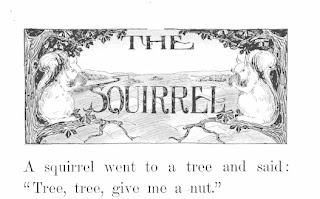Excerpt from The Mothercraft Manual By Mary Lillian Read, 1922(downloadable and free):
For the child under six years, and possibly under ten, the most educative environment, in every sense, is in the country with hills, valleys, woods, water, plants and trees, wild and domestic animals, other young children, the freedom of the kitchen, the necessity for personal physical care, and elders who enter sympathetically into his life, not obtrusively but intelligently, ready to give assistance when it is needed. With good library facilities, wholesome neighborhood recreations, and occasional trips to a city for its opportunities of art galleries, great music, wholesome plays, industrial activities, the simple home life and rural surroundings, even with mediocre teaching in a rural school, provide through early adolescence the environment most favorable for developing richness of life, greatness of personality, social efficiency.
Intellectual and Play Interests. 2 to 6 years.
Sensory and motor stage: Range of active sensory experiences, — tasting, touching, hearing, seeing
Interest in color, sound, tasting, strongest at 4 to 6 years
Constant sensory experimentation and exploration
Experimental science; taking apart; finding source of motion or noise Nature interest; animals, birds, insects, flowers; watching actions, noting striking characteristics of appearance
Interest in experimenting with material (2 to 4 years); in making for use (4 to 6 years)
All work crude; materials large, coarse, utilizing fundamental muscles; periods short, to avoid strain of eyes or nerves
Handcrafts:
(a) Building, digging, sand play (from one year)
(b) Carpentry, drawing, painting, modeling (from two years)
(c) Cutting, pasting, heavy paper construction (from 4 years)
(d) Coarse weaving, cardboard construction (from 5 years)See entire curriculum here, baby to early childhood. Some ideas are obviously outdated, but others are still relevant.
"Knowledge has little or no intrinsic value in and of itself. Like light, knowledge is good not to see but to see by. . . . Ignorance is doubtless better than knowledge that does not make us better."
— G. Stanley Hall.
"Where children are fed only on book knowledge, one fact is as good as any other." . —John Dewey.
"If we seek the kingdom of heaven, educationally, all other things shall be added unto us — which, being interpreted, is that if we identify ourselves with the real instincts and needs of childhood, and ask only after its fullest assertion and growth, the discipline and information and culture of adult life shall all come in their due season." — Ibid.
...developing character, — the ideals and the realization of noble living, — which has its roots deep in the feelings and the soul, and depends upon these far more than upon mere thought, knowledge, and reasoning.
"Play is the highest phase of child-development — of human development at this period (childhood); for it is self-active representation of the inner, from inner necessity and impulse."
"The plays of childhood are the germinal leaves of all later life; for the whole man is developed and shown in these."
"Come, let us live with our children."
— F. Froebel






















